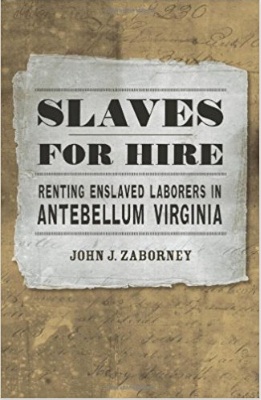“Slaves for Hire” surveys the practice of renting enslaved laborers in Antebellum Virginia, “Black Jacks” looks at rented slaves and free blacks in seafaring roles across the 18th and 19 centuries, and “Divided Mastery” looks at the common practices of slave hiring throughout the entire South, especially in the Antebellum period.
Slaves for Hire

Slaves for Hire: Renting Enslaved Laborers in Antebellum Virginia (2012) by John J. Zaborney looks at the practice of hiring out slaves as rented labor by the white population across industries, socioeconomic status and gender. The practice which was widespread with society-wide implications has been largely understated, in part because its complexity resists characterizations as either exploitive or quasi-liberating for the rented slave.
During the time of Virginia’s diversification and industrialization, Zaborney uses social history to look at owner-hirer-slave interrelationships, in urban and rural settings, for men, women and children in a dynamic and changing economy.
The owner’s profit-maximizing practice was applied to field hands, domestic servants, coal miners and railroad builders; depending on circumstances, the rented slave enjoyed nearly full autonomy or ruthless industrial exploitation. Buy “Slaves for Hire” here at Amazon.com.
Black Jacks

Black Jacks: African American Seamen in the Age of Sail (1998) by W. Jeffrey Bolster addresses the multi-generational development of a free black middle class across every phase of American maritime life, from cooks to able bodied seamen to captains. The working conditions were preferable to those working on land, including for those who were rented slaves aboard ship, and benefits included a decent wage and greater personal freedom.
The needs of the ship at sea determined the social order for those on board, and there, race was a tertiary consideration among interrelationships rather than the primary one.
Following the growth in the eighteenth and early nineteenth century to twenty percent of U.S. seafaring population, African-American participation in seafaring occupations declined precipitously in the second half of the nineteenth century following the Civil War. Buy “Black Jacks” here at Amazon.com.
Divided Mastery

Divided Mastery: Slave Hiring in the American South (2004) by Jonathan D. Martin explores the powerful economic utility and adaptive nature of slavery throughout the South, especially in the Antebellum period. By 1850, hiring out was no longer a step toward freedom or even relative independence amidst increasingly industrial settings.
Martin studies slavery and the practice of hiring out slaves from the point of view of masters, renters and the slaves rented. Although he traces beginnings of the practice in the Carolinas and the Chesapeake, he addresses the entire South and focuses on the similarities of practice. Slave-initiated self-hiring was outlawed by southern legislatures in the 1850s, further limiting any special opportunities for the slave to shape their everyday existence. Buy “Divided Mastery” here at Amazon.com.
For a 12-step guide for building your personal Virginia History library, and reviews of additional selections, see the Book Club at TheVirginiaHistorian.com.

